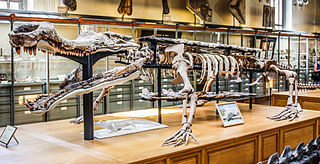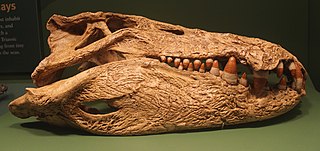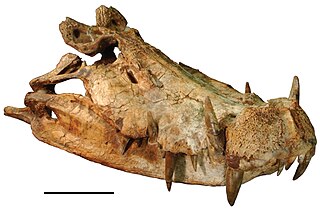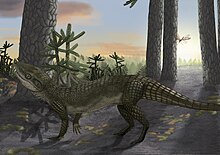
Sarcosuchus is an extinct genus of crocodyliform and distant relative of living crocodilians that lived during the Early Cretaceous, from the late Hauterivian to the late Cenomanian, 133 to 93 million years ago of what are now North Africa and South America. The genus name comes from the Greek σάρξ (sarx) meaning flesh and σοῦχος (souchus) meaning crocodile. It was one of the largest pseudosuchians, with the largest specimen of S. imperator reaching approximately 9–9.5 metres (29.5–31.2 ft) long and weighing up to 3.45–4.3 metric tons. It is known from two species; S. imperator from the early Albian Elrhaz Formation of Niger, and S. hartti from the Late Hauterivian of northeastern Brazil. Other material is known from Morocco and Tunisia and possibly Libya and Mali.

Deinosuchus is an extinct genus of alligatoroid crocodilian, related to modern alligators and caimans, that lived 82 to 73 million years ago (Ma), during the late Cretaceous period. The name translates as "terrible crocodile" and is derived from the Greek deinos (δεινός), "terrible", and soukhos (σοῦχος), "crocodile". The first remains were discovered in North Carolina in the 1850s; the genus was named and described in 1909. Additional fragments were discovered in the 1940s and were later incorporated into an influential, though inaccurate, skull reconstruction at the American Museum of Natural History. Knowledge of Deinosuchus remains incomplete, but better cranial material found in recent years has expanded scientific understanding of this massive predator.

Doratodon is an extinct genus of Late Cretaceous crocodylomorph that may have been a member of the Sebecosuchia. Doratodon was a relatively small animal with ziphodont teeth, meaning the teeth had flattened sides and serrated edges. Two species of Doratodon are known to science: D. carcharidens from Austria and Hungary, the type species; and D. ibericus from Spain. Teeth similar to those of Doratodon are also known from Italy and Romania, though they cannot be confidently assigned to this genus.

Simosuchus is an extinct genus of notosuchian crocodyliforms from the Late Cretaceous of Madagascar. It is named for its unusually short skull. Fully grown individuals were about 0.75 metres (2.5 ft) in length. The type species is Simosuchus clarki, found from the Maevarano Formation in Mahajanga Province, although one isolated multicuspid tooth of this genus was discovered in Kallamedu Formation of India.

Mahajangasuchus is an extinct genus of crocodyliform which had blunt, conical teeth. The type species, M. insignis, lived during the Late Cretaceous; its fossils have been found in the Maevarano Formation in northern Madagascar. It was a fairly large predator, measuring up to 4 metres (13 ft) long.

Anatosuchus is an extinct genus of notosuchian crocodylomorph discovered in Gadoufaoua, Niger, and described by a team of palaeontologists led by the American Paul Sereno in 2003, in the Journal of Vertebrate Paleontology. Its duck-like snout coincidentally makes it resemble a crocoduck, an imagined hybrid animal with the head of a crocodile and the body of a duck.

Mariliasuchus is an extinct genus of Late Cretaceous notosuchian crocodyliforms found near Marilia, Brazil. The first bone remains were found and collected in 1995 by Brazilian paleontologist William Nava, in red rocks from the fossiliferous Adamantina Formation. Four years later, it was described as Mariliasuchus amarali, by Brazilian paleontologists Ismar de Souza Carvalho and Reinaldo J. Bertini.
Malawisuchus is an extinct genus of notosuchian mesoeucrocodylian from the Early Cretaceous Dinosaur Beds of Malawi. It was described in 1997 by Elizabeth Gomani as a member of the family Notosuchidae. The type species is M. mwakasyungutiensis, referring to Mwakasyunguti, the area of northern Malawi where it was found. It was classified as a member of the family Itasuchidae by Carvalho and colleagues in 2004.
Trematochampsidae is an extinct family of mesoeucrocodylian crocodyliforms. Fossils are present from Madagascar, Morocco, Niger, Argentina, and Brazil. Possible trematochampsids have been found from Spain and France, but classification past the family level is indeterminant. The trematochampsids first appeared during the Barremian stage of the Early Cretaceous and became extinct during the late Maastrichtian stage of the Late Cretaceous.

Armadillosuchus is an extinct genus of sphagesaurid crocodylomorph. It was described in February 2009 from the late Campanian to early Maastrichtian Adamantina Formation of the Bauru Basin in Brazil, dating to approximately 70 Ma. Armadillosuchus was among the larger and more robust sphagesaurids, with a total length of approximately 2 metres (6.6 ft).

Bergisuchus is an extinct genus of small sebecosuchian mesoeucrocodylian known primarily from the Eocene Messel Pit in Germany. Few fossils of Bergisuchus have been discovered, only a single incomplete snout, a few partial lower jaws and some teeth. Despite being fragmentary, the jaw bones are enough to indicate that Bergisuchus had a short, deep, narrow snout and serrated teeth, quite unlike the broad flat snouts of modern crocodylians.

Kaprosuchus is an extinct genus of mahajangasuchid crocodyliform. It is known from a single nearly complete skull collected from the Upper Cretaceous Echkar Formation of Niger. The name means "boar crocodile" from the Greek κάπρος, kapros ("boar") and σοῦχος, soukhos ("crocodile") in reference to its unusually large caniniform teeth which resemble those of a boar. It has been nicknamed "BoarCroc" by Paul Sereno and Hans Larsson, who first described the genus in a monograph published in ZooKeys in 2009 along with other Saharan crocodyliformes such as Anatosuchus and Laganosuchus. The type species is K. saharicus.

Sebecus is an extinct genus of sebecid crocodylomorph from Eocene of South America. Like other sebecosuchians, it was entirely terrestrial and carnivorous. The genus is currently represented by two species, the type S. icaeorhinus and S. ayrampu. Several other species have been referred to Sebecus, but were later reclassified as their own genera.

Galulatherium is an extinct genus of possibly gondwanathere mammal, from the Late Cretaceous (Turonian-Campanian)-aged Galula Formation of Tanzania. It is known solely from the type specimen TNM 02067 a fragmentary fossil dentary. The short, deep bone is about 19.5 mm (0.77 in) long, but the back part is broken off. It contains a large, forward-inclined incisor with a root that extends deep into the jaw, separated by a diastema (gap) from five cheekteeth. Very little remains of the teeth, but enough to determine that they are hypsodont (high-crowned). The third cheektooth is the largest and the roots of the teeth are curved. First described in 2003, TNM 02067 has been tentatively identified as a sudamericid—an extinct family of high-crowned gondwanathere mammals otherwise known from South America, Madagascar, India, and Antarctica. If truly a gondwanathere, it would be the only African member of the group and may be the oldest. The describers could not exclude other possibilities, such as that the jaw represents some mammalian group known only from younger, Cenozoic times. In 2019 the fossil was CT scanned, which revealed additional details of the specimen.

Barreirosuchus is an extinct genus of trematochampsid notosuchian known from the Late Cretaceous of São Paulo State, southeastern Brazil. It contains a single species, Barreirosuchus franciscoi. It is most closely resembles Caririsuchus camposi from the Araripe Basin and Itasuchus jesuinoi also from the Bauru Basin, and shares with them several synapomorphies.
Rukwasuchus is an extinct genus of peirosaurid crocodyliforms known from the middle Cretaceous Galula Formation of southwestern Tanzania. It contains a single species, Rukwasuchus yajabalijekundu.
Shingopana is a genus of titanosaurian sauropod from the Upper Cretaceous Galula Formation of Tanzania. It is known from only the type species, S. songwensis. Gorscak & O'Connor's phylogenetic testing suggest Shingopana is more closely related to the South American titanosaur family of Aeolosaurini than any of the titanosaurs found so far in North & South Africa.
The Galula Formation is a geological formation located south of Lake Rukwa in Tanzania, part of the Red Sandstone Group of the Rukwa Rift Basin. Along with the unconformably overlying Oligocene Nsungwe Formation. It is divided into two members, the lower Mtuka Member and the upper Namba Member.
Barrosasuchus is a genus of peirosaurid notosuchian from the Santonian of Argentina and part of the extensive peirosaurid record of Late Cretaceous Patagonia. It contains one species, Barrosasuchus neuquenianus. B. neuquenianus is known from an almost complete skull and the majority of the articulated postcranial skeleton, making it the best preserved Patagonian peirosaurid.

Confractosuchus is a genus of extinct eusuchian crocodyliform from the Cretaceous Winton Formation of Australia. Described as a macro-generalist, Confractosuchus was found with the bones of a juvenile ornithopod dinosaur in its abdomen. It currently contains a single species, Confractosuchus sauroktonos, which literally means "broken dinosaur killer."
















